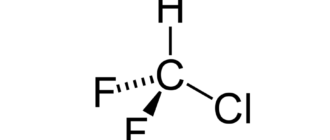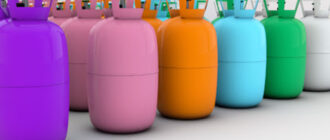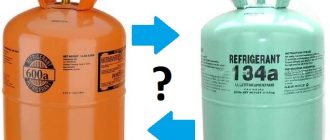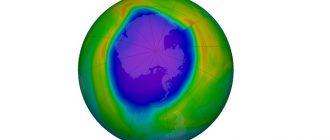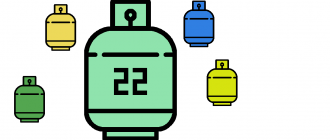Обновлено: 11 June 2022.
This article will discuss R32, the properties, characteristics and features of this refrigerant. We will tell you how it differs from analogues. You will find out why R32 gas is replacing the 410 refrigerant. We also provide tables of characteristics.
History of appearance
Initially, R-32 refrigerant (difluoromethane, HFC-32) was used as part of R-410a freon. Since 2012, Daikin has been producing residential and commercial air conditioners powered by R-32 gas. Over time, other companies began to produce such equipment. Daikin, on the other hand, does not mark time and introduces new developments.
A bit of history
In May 2017, Daikin introduced the Sky Air A-series range of air conditioners powered by a promising new refrigerant. There are three models of outdoor units in the A series: Alpha, Advance and Active.
In addition, Daikin has upgraded Sky Air indoor units to run on both R-410A and R-32 refrigerants . As in the case of other split systems, the company guarantees users that during the service life of 10-15 years, systems on the R410A will be maintained and serviced.
The popularity of the R32 refrigerant is due to the fact that by 2025 the production of climate control equipment on R410a with a refrigerant working weight of less than 3 kg will be prohibited. The reason is global warming potential. For R32 refrigerant, it is 2.8 times or 64.3% lower than for R410a.
R32 refrigerant meets the EU requirements for F-gases for small air conditioning systems with one split unit after 2025. Restriction of the use of R410a refrigerant comes into force from 2025 according to the new regulation (EU) No. 517/2014.
The GWP value (Global warming potential, global warming potential) for R32 is 645. For R410a gas GWP is 2088. These figures actually mean that one ton of the 32nd refrigerant gives the same greenhouse effect as 645 tons of carbon dioxide.

Application
Tests have shown that R32 freon is 5-6% more efficient than R410a refrigerant (due to lower viscosity). The experiments were carried out on air conditioners up to 4 kW or 13,600 BTU. With the same heating and cooling capacity, R-32 needs 30% less than R-410a. Accordingly, the dimensions of the equipment can be reduced.
Since R32 is a one-component gas, it does not have a temperature glide. It can be topped up in the event of a leak. It is only compatible with polyester (POE) compressor oils. The refrigerant can be charged in both liquid and gaseous phases. In terms of cooling capacity, it is the same as R22 and R502 gases.
R-32 refrigerant is used in:
- Household air conditioners;
- Industrial air conditioners;
- Chillers;
- Heat pumps.
R-32 also used in multicomponent (mixed) refrigerants, such as:
- R-407c;
- R-407f;
- R-410a;
- R-442a;
- R-453a.
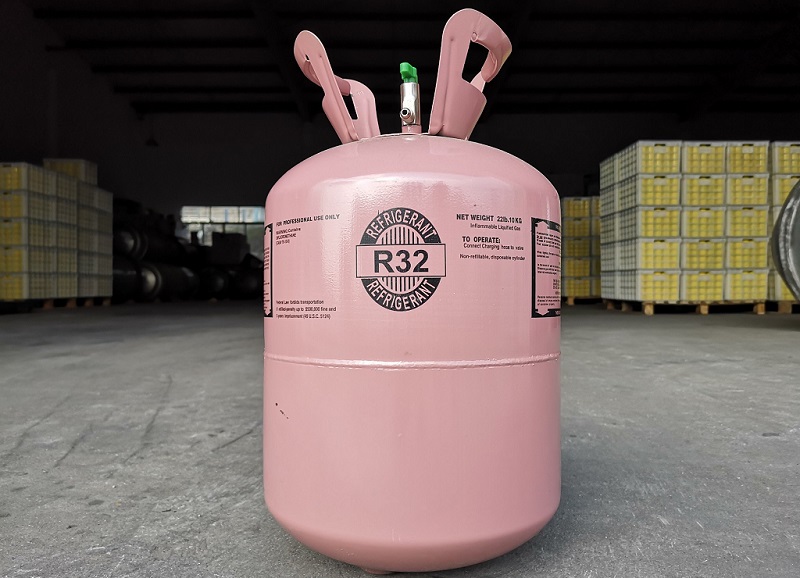
Redrigerant (freon) R32 properties (tables)
General properties r32
| Characteristics R32 | Value |
|---|---|
| Name | difluoromethane |
| Chemical formula | CH2F2 |
| Molecular mass | 52.02 g/mol |
| Boiling temperature | -51.65 °С |
| Melting temperature | -136 °С |
| Solubility in water at 25 °C | 0.44% |
| Density (liquid) at 25 °C | 1.052 g/cm3 |
| Density (gas) at 25 °C | 0.961 kg/m3 |
| Density (liquid) at -51.65 °C | 1.21 g/cm3 |
| Critical Density | 0.425 g/cm3 |
| Critical volume | 121 cm3/mol |
| Critical temperature | +78.4 °С |
| Critical pressure | 5.843 MPa |
| Auto ignition temperature | +648 °С |
| Global Warming Potential GWP (100 years) | 675 |
| Ozone Depletion Potential ODP | – |
| Appearance | Colorless |
| Maximum allowable concentration (mg/m3) | 3000 |
| Maximum allowable concentration (ppm) | 1000 |
Dynamic (absolute) viscosity
| Absolute viscosity | Value |
|---|---|
| Gas at +5 °C | 0.0132 cpoise |
| Gas at +50 °С | 0.0122 cpoise |
| Liquids at +5 °C | 0.188 spoise |
| Liquids at +50 °C | 0.099 spoise |
The dynamic viscosity η (η = “eta”) is a measure of the viscosity of a fluid (fluid: liquid, flowing substance).
The higher the viscosity, the thicker (less liquid) the fluid; the lower the viscosity, the thinner (more liquid) it is.
SI unit of dynamic viscosity: [η] = Pascal-second (Pa*s) = N*s/m² = kg/m*s
Thermal conductivity
| Thermal conductivity at the saturation line | Value |
|---|---|
| Gas at +5 °C | 0.010 W/(m*K) |
| Gas at +50 °C | 0.012 W/(m*K) |
| Liquids at +5 °C | 0.143 W/(m*K) |
| Liquids at +50 °C | 0.107 W/(m*K) |
Pressure and temperature dependence
| T, °C | P, barA | P, barg | P, psig | T, °C | P, barA | P, barg | P, psig |
|---|---|---|---|---|---|---|---|
| -70 | 0.36 | -0.65 | -9.46 | 2 | 8.66 | 7.65 | 110.95 |
| -68 | 0.41 | -0.61 | -8.77 | 4 | 9.22 | 8.21 | 119.07 |
| -66 | 0.46 | -0.55 | -8.02 | 6 | 9.81 | 8.80 | 127.58 |
| -64 | 0.52 | -0.50 | -7.19 | 8 | 10.43 | 9.41 | 136.49 |
| -62 | 0.58 | -0.43 | -6.27 | 10 | 11.07 | 10.06 | 145.81 |
| -60 | 0.65 | -0.36 | -5.27 | 12 | 11.74 | 10.73 | 155.57 |
| -58 | 0.73 | -0.29 | -4.17 | 14 | 12.45 | 11.43 | 165.76 |
| -56 | 0.81 | -0.21 | -2.98 | 16 | 13.18 | 12.17 | 176.41 |
| -54 | 0.90 | -0.12 | -1.67 | 18 | 13.95 | 12.93 | 187.53 |
| -52 | 1.00 | -0.02 | -0.26 | 20 | 14.75 | 13.73 | 199.13 |
| -50 | 1.10 | 0.09 | 1.28 | 22 | 15.58 | 14.57 | 211.21 |
| -48 | 1.22 | 0.20 | 2.95 | 24 | 16.45 | 15.44 | 223.81 |
| -46 | 1.34 | 0.33 | 4.75 | 26 | 17.35 | 16.34 | 236.93 |
| -44 | 1.47 | 0.46 | 6.69 | 28 | 18.30 | 17.28 | 250.59 |
| -42 | 1.62 | 0.61 | 8.78 | 30 | 19.28 | 18.26 | 264.80 |
| -40 | 1.77 | 0.76 | 11.04 | 32 | 20.29 | 19.28 | 279.57 |
| -38 | 1.94 | 0.93 | 13.45 | 34 | 21.35 | 20.34 | 294.93 |
| -36 | 2.12 | 1.11 | 16.05 | 36 | 22.45 | 21.44 | 310.89 |
| -34 | 2.31 | 1.30 | 18.82 | 38 | 23.60 | 22.58 | 327.47 |
| -32 | 2.52 | 1.50 | 21.79 | 40 | 24.78 | 23.77 | 344.67 |
| -30 | 2.73 | 1.72 | 24.96 | 42 | 26.01 | 25.00 | 362.51 |
| -28 | 2.97 | 1.95 | 28.34 | 44 | 27.29 | 26.28 | 381.05 |
| -26 | 3.22 | 2.20 | 31.94 | 46 | 28.62 | 27.60 | 400.24 |
| -24 | 3.48 | 2.47 | 35.77 | 48 | 29.99 | 28.98 | 420.15 |
| -22 | 3.76 | 2.75 | 39.83 | 50 | 31.41 | 30.40 | 440.79 |
| -20 | 4.06 | 3.04 | 44.15 | 52 | 32.89 | 31.87 | 462.17 |
| -18 | 4.37 | 3.36 | 48.72 | 54 | 34.42 | 33.40 | 484.33 |
| -16 | 4.71 | 3.69 | 53.56 | 56 | 36.00 | 34.98 | 507.27 |
| -14 | 5.06 | 4.05 | 58.68 | 58 | 37.64 | 36.62 | 531.02 |
| -12 | 5.43 | 4.42 | 64.09 | 60 | 39.33 | 38.32 | 555.63 |
| -10 | 5.83 | 4.81 | 69.79 | 62 | 41.09 | 40.08 | 581.10 |
| -8 | 6.24 | 5.23 | 75.81 | 64 | 42.91 | 41.90 | 607.49 |
| -6 | 6.68 | 5.67 | 82.15 | 66 | 44.79 | 43.78 | 634.81 |
| -4 | 7.14 | 6.13 | 88.82 | 68 | 46.75 | 45.73 | 663.11 |
| -2 | 7.62 | 6.61 | 95.84 | 70 | 48.77 | 47.76 | 692.45 |
| 0 | 8.13 | 7.12 | 103.21 |
Special features r32
The information provided here will be useful to specialists. It is unlikely to be useful to people working with conventional air conditioners, chillers or heat pumps. Here are the characteristics of refrigerant R32:
- Dielectric constant – 26.11 F / m at -49.2 ° C ;
- The standard enthalpy of formation is -425.3 kJ / mol at +25 ° C ;
- The standard entropy of a substance is 246.7 kJ / (mol * K) ;
- Standard molar heat capacity – 42.9 kJ / (mol * K) ;
- The ratio of volumes of equal amounts of gas and liquid at 1 atm. and +21 °C – 352 ;
- Specific heat of evaporation (condensation) – 360-390 kJ ;
- The heat capacity of the liquid at the saturation line at +25 °C is 2.35 kJ/(kg*°C) ;
- Molar heat capacity of a gas at constant pressure at 1 atm. and +21 °C – 0.043 kJ / (mol * k) ;
- Molar heat capacity of gas at constant volume at 1 atm. and +21 °C – 0.034 kJ / (mol * k) .
Interchangeability of R32 and R410a
There are three types of HVAC equipment on the market today. Legacy models only run on R-410a. Modern – on the R-32. There is a class of air conditioners that can operate on both refrigerants.
Manufacturers of R32 freon do not recommend using it in equipment designed for R410a refrigerant. Most likely this warning is done for reinsurance. Many air conditioners and service centers charge old air conditioners with new refrigerant.
In terms of performance, R32 is almost no different from R410a. The first has a boiling point of only 0.2 degrees lower than the second. The condensing pressure of R32 gas is only 1.8% or 0.5 bar higher than that of R410a. Read more in the article: R-410a vs R-32 – which refrigerant is better, more profitable, more efficient.
Human danger
R32 refrigerant is considered a fire hazard. But it belongs to the A2L class. In this abbreviation, the first letter “A” means that the gas has low toxicity. And the designation “2L” means that it refers to substances of medium fire hazard. Substance class A2L has the following characteristics:
- Concentration in air for burning more than 0.3 kg/m3;
- Burning speed <10 cm/s;
- Calorific value <19000 kJ/kg;
- Limiting concentration in air >400 ppm.

If R32 refrigerant leaks, it may ignite. But this requires special conditions. A normal spark cannot ignite it. For refrigerant to ignite, an energy of at least 15 megajoules is needed. In addition, it will burn if its concentration in the air is from 13.3% to 29.3% (according to studies published by the Consortium of European Historical Libraries).
If R32 is exposed to other concentrations at high temperatures, it decomposes. In this case, fluorides are formed. Some of them pose a health risk.
R32 refrigerant is almost 2 times heavier than air. When leaking, it accumulates at the bottom. Accordingly, it is very difficult for them to breathe. This gas actually does not pose a threat to humans.
In this publication, we have provided the properties of R32 refrigerant. We hope they were complete and the article was useful to you. You can leave your opinion and questions in the comments. Don’t forget to share the post with your friends and colleagues!
Хотите получить помощь мастера, специалиста в этой сфере? Переходите на портал поиска мастеров Профи. Это полностью бесплатный сервис, на котором вы найдете профессионала, который решит вашу проблему. Вы не платите за размещение объявления, просмотры, выбор подрядчика.
Если вы сами мастер своего дела, то зарегистрируйтесь на Профи и получайте поток клиентов. Ваша прибыль в одном клике!

